Radio market research is important. But successful radio programming is more than cluster mapping, music testing and image tracking, as German cases show.
Bavarian media association BLM commissioned a study about radio listener needs during morning show and afternoon drive. After its presentation, 3 PDs and a research expert talked about it in a panel. Takeaway #1: sometimes we have to ignore the paralyzing risk of research, and embrace the competitive advantage of innovation.
Monitor image values constantly
ANTENNE BAYERN (AC) is the only statewide licensed private radio station in Bavaria and on air since 1988. About 24 years later it reaches 1.3 million listeners during the average hour of which about 800.000 belong to the beloved 20- to 49-year-old consumer demographic (source: MA 2012-II). An interesting side effect of being so dominant is that ANTENNE BAYERN owns basically every image there is – and images are key performance indicators. “When we have high images, we also have high ratings”, program director and general manager Valerie Weber explains. Continuous CATI research allows them to spot trends and follow developments. The station interviews about 5,000 people a year.
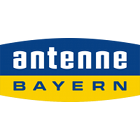 Look for larger deviations
Look for larger deviations
Because ANTENNE BAYERN is so top of mind, they automatically own some negative images, too. “When it’s about which radio station ‘talks too much’ or ‘plays too many commercials’, we’re the number 1, too”, Weber says honestly. Therefore they focus on images that are absolutely over or below average, as well as on larger developments and trends, of course. “Sometimes images can really push the station, and sometimes they follow the station.”
Become top of mind
There’s limited room in the listener’s mind: “If people are being asked which radio stations they know, they usually mention 2 or 3”, says Jörg Sunnus. He’s responsible for radio research at the German institute IFAK. The average ‘listened yesterday’ recall is 1.7 stations. Most people switch between a maximum of 4 stations, of which they know only 3 well. Looks like it’s important to get your brand into the listener’s mental Top 3. About ANTENNE BAYERN’s phenomenon of wide-spread images, Sunnus explains: “If you ask: who covers topic X the most, favorite brands are mentioned more often – also when it’s about negative images. When people listen to your program intensively and don’t like certain things, they’ll notice them sooner than with stations that they don’t listen to so much.”
“More important than what you do, is how you do it”
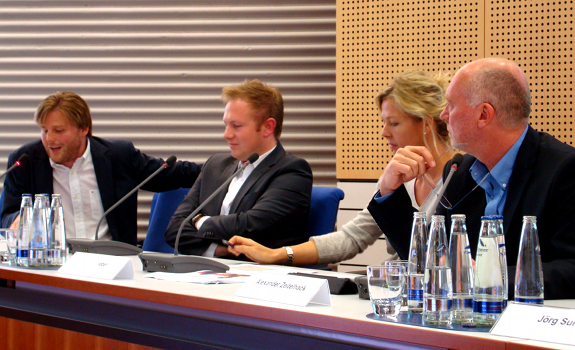
Program director Frank Beyhl (left) of 106,9 Radio Gong in Würzburg says that local radio stations should focus on local program content, but also make sure it’s produced well to avoid audience tune-out (photo: Thomas Giger)
Structure news formats strategically
Over the last couple of years, audience research shows an increasing demand for locality. ANTENNE BAYERN decided to fulfill this need and bring more local news – even though they’re a statewide radio station. “We’ve made our news bulletins longer than those of our public radio competitors, which was a risk for us”, says program director and general manager Valerie Weber. She reveals that this is the exact reason why they program the weather forecast before the news. It prevents that they go much later back into the music than the public radio stations do.
 Focus on perfect execution
Focus on perfect execution
Local radio should become even more local, is the opinion of Frank Beyhl, who programs Hot AC 106,9 Radio Gong in Würzburg. In different parts of the Free State, audiences prefer (slightly) different topics than in others – and who can fine-tune content for local listeners better than local radio? However: “More important than what you do, is how you do it. When you play five-minute sound bites of a local politicians, it will surely result in a loss of audience.”
Avoid endless sponsor interruptions
Beyhl compliments his statewide competitor for the way they handle political topics. “It’s simply and clearly structured. I can listen to it in the morning while I’m brushing my teeth without having a university degree.” His colleague Bernd Rasser, program director and morning anchor of Full Service AC Radio Mainwelle in Bayreuth, tries to avoid a load of sponsor messages inside and around a news and service bulletin. Doing many things like ‘the weather is brought to you by…’ can be a major turn-off. “When you hear 6 sponsors inside the half-hour headline break alone, you don’t need a study to know: this can’t be it.”
“As local stations together you can do so much better”
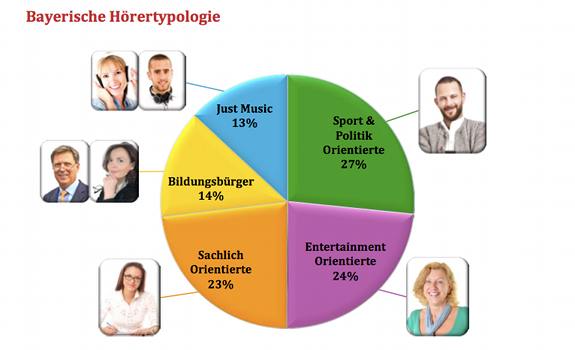
Radio listener groups in the German Free State: Sports & Politics Oriented (green), Entertainment Oriented (purple) and Business Oriented (orange) people, followed by Educated Civilians (yellow) and Just Music (blue) (slide: IFAK)
Approach small markets mainstream
Program director Harry Landauer of Radio Charivari (AC) and gong fm (Hot AC) in Regensburg, who sits in the audience, addresses the challenge of keeping everyone in his target demo satisfied. In reference to the above overview of listener typologies in the Free State, he says: “When I make the FC Bayern fan on the top right happy, the [insurance company] employee on the right bottom is on her way to the switch button.” What is the future of local radio? Mainstream or niche? “As a local station you’re unfortunately cursed to do exactly the same as ANTENNE BAYERN”, PD Valerie Weber says. She thinks that local radio should not focus on one specific audience within a small market. In Bavaria, most smaller city areas have less than 100,000 inhabitants.
 Develop separate niche brands
Develop separate niche brands
Weber jokes that government-funded Hot AC BAYERN 3, her main competitor, “will hopefully keep serving the Educated Citizens” (see ‘Bildungsbürger’ in the chart above). “We have the rest.” Mass-appeal ANTENNE BAYERN does have a separate niche brand which is doing okay. ROCK ANTENNE reaches about 85.000 listeners/hour on average (source: MA 2012-II). “Really honest: this will only become interesting when you have more frequencies.”
Start sub-local station collaborations
“When local stations would unite themselves within bigger station groups, they could floor us instantly, including the public radio stations”, is Weber’s free advice to her local competitors. It would bring more variety in a market where even the public broadcaster’s main channels BAYERN 1 (Full Service AC) and BAYERN 3 are playing within the 14-59 field. This not only affects ANTENNE BAYERN, but also local radio – which depends on ad sales, too. “My answer would be: unite yourself, because as local stations together you can do so much better. You could even adjust the music better [towards local audiences] than we can.”
“A local station should be the market leader”
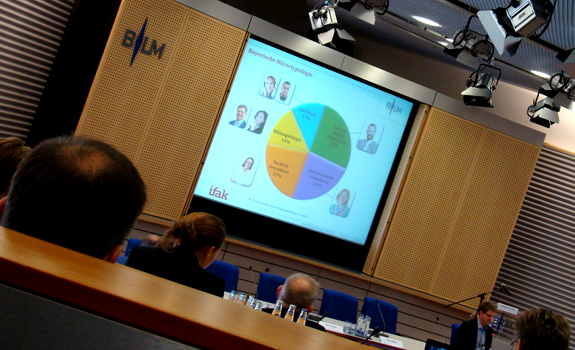
Radio researcher Jörg Sunnus of the IFAK institute is convinced that local radio stations can lead their markets by playing their trumph card of unique localness while avoiding audience-polarizing content (photo: Thomas Giger)
Coordinate music formats & research
The program director of ANTENNE BAYERN, who once started her career in local radio, advises small-market stations to divide the market in terms of music formats in collaboration with each other. She thinks that every audience typology would benefit from a wider spread of musical colors on a local level. “It’s now the same everywhere; we all play Robbie Williams and Pink.” Radio Mainwelle’s program director Bernd Rasser is asking the BLM to do state-wide music testing and give all local stations access to the reports. Most of them don’t have a budget to commission their own music research.
 Keep local roots & identity
Keep local roots & identity
“When it comes to music or marketing we can certainly use a lot of synergy”, 106,9 Radio Gong PD Frank Beyhl (photo) supports the idea, at the same time pointing out that networking based on syndicated programming may not be the answer. He thinks local radio should remain independent and focus on local, self-produced content because it’s a USP. “Especially in our globalized world, people value traditions and they think more and more locally.”
Make local content matter
“When it’s executed smart, a local station should be the market leader”, radio researcher Jörg Sunnus confirms. But the content should matter. Research about radio listener needs during prime-time hours in the German state of Bavaria shows that political topics are loved by almost everyone, while sports and economy drive the male and female parts of your audience apart. “Everything that’s polarizing, is thin ice”, according to Sunnus. “Stop and think: is this topic really relevant, and how long do I talk about it?” He emphasizes that relevance is key; it creates attention. Boring topics really need a good angle. If there’s no original approach, listeners quickly go elsewhere.
“Market research is a rear-view mirror”

ANTENNE BAYERN program director & general manager Valerie Weber, here with CEO Karlheinz Hörhammer, believes in gut feeling first and music testing later, in terms of adding new songs (photo: ANTENNE BAYERN)
Organize station & community events
Research is important for ANTENNE BAYERN, but it’s not everything. “If we would fully act upon research, we would make a very bad program”, says PD/GM Valerie Weber. “If you’re always afraid to polarize, your presenters won’t open their mouths anymore and your editors will avoid sports completely. But often it’s the only thing you can be proud of within a community. So when your darn ice hockey team has won, celebrate it!” Program director and morning personality Frank Beyhl of 106,9 Radio Gong recalls that when their local basketball team promoted to the first league, thousands of people came to the station’s celebration party – even if they weren’t interested in the actual game. To him, it proves that sports are a great way to share mutual feelings that create a bond. He says that radio is the perfect medium for it. “Radio is emotion.”
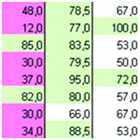 Keep playing new music
Keep playing new music
When ANTENNE BAYERN developed a new comedy series, they did research to see whether listeners would like it. “It’s the same as with new music”, says Valerie Weber. “The results you’re getting back are so shitty. If you do music research, you know that people hate new songs and unfamiliar music.” In her experience, the biggest tune-out factor within the hour is when you play that new song – it’s even worse than the commercial break.
See research as feedback
On moments like these, she says, it’s important to trust your instincts. “You have to close your eyes and say: my gut feeling tells me that this is going to be a huge hit. Then I sit there and think: oh my God, please let it work, because we’ll really be playing it back and forth”, Valerie Weber says. Once a new playlist addition is familiar enough, it’s being included in the music test. “When the audience feels differently than we do, that song might disappear from the playlist within 2 weeks.” She and her team base day-to-day programming decisions on gut feeling, and use research to check whether it was right. “A smart man once said: market research is a rear-view mirror.” She adds that market mapping studies (such as defining music clusters) are, of course, essential for developing successful radio formats.
“Innovation is in the Schumpeterian sense
a competitive advantage in itself”
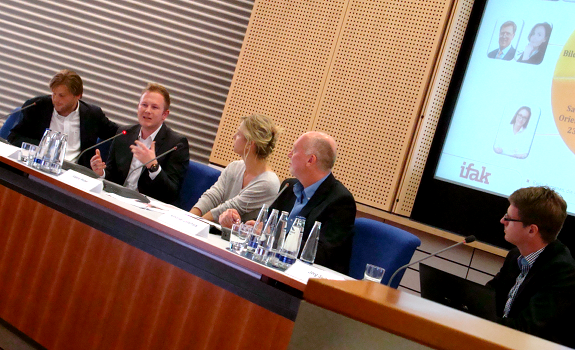
From left to right: the panel of Frank Beyhl (106,9 Radio Gong), Bernd Rasser (Radio Mainwelle), Valerie Weber (ANTENNE BAYERN), Alexander Zeitelhack (session host), and Jörg Sunnus (IFAK) (photo: Thomas Giger)
Drive audience through content
IFAK radio researcher Jörg Sunnus has noticed that in radio, especially new music and new comedies have a ‘burn in’ period, as the audience needs time before they can appreciate unfamiliar things. “People have to get to know the characters that appear in a comedy first. If, after a few months, it still doesn’t produce good results, then it should be taken out of the program.” Based on studying radio listener needs during morning show and afternoon drive he concludes that while certain topics can polarize groups of listeners, you can steer your audience profile in a desired direction by leaving out or adding certain content. Stations that want to attract more male listeners, for example, will most likely increase their share within this target audience by offering (more) well-produced sports and economy news on the air.
 Make progression your advantage
Make progression your advantage
Session host Alexander Zeitelhack brings back a scene from Private Parts (one of the coolest radio movies of all time) where it turns out that people who hate Howard Stern generate more Time Spent Listening than those who love him. Polarizing is an extreme form of moving forward. Zeitelhack: “Innovation is in the Schumpeterian sense a competitive advantage in itself. If you want to improve your position, you are forced to rely on innovations.”
Balance on-air station tonality
The BLM Positioning Study 2012 shows that what the radio listener needs during morning show and afternoon drive are personalities which are ‘believable, friendly and to the point’. ANTENNE BAYERN PD Valerie Weber sees a contradiction between the last two. “Men come to the point soon, but as a result, some won’t sound particularly friendly.” She sees in focus groups that most men are results-oriented and keep comments brief, while most women are social-oriented and enjoy actual conversations. [For more, see: expansive listening vs. reductive listening in The Future Of Radio: Become A Trusted Guide In Sound].
“He doesn’t want to come across as superior”

ANTENNE BAYERN radio personality Wolfgang Leikermoser only shares interests and hobbies on air that resonate with the audience of the radio station and his morning show ‘Guten Morgen Bayern’ (photo: ANTENNE BAYERN)
Level with the audience
Weber also feels tension between being friendly and believable. “Last night I’ve had a discussion with a female host in which I’ve said: you’re often too friendly to be believable. How much kindness will the listener tolerate before he says: no-one can always be in such a good mood; something’s not right here?” She also finds it important that radio personalities sound like being on the same level as the audience. ANTENNE BAYERN’s morning show host Wolfgang Leikermoser is very well educated and even does “wild things like attending classical concerts at night”, but he won’t talk about it during Guten Morgen Bayern. “He doesn’t want to come across as superior.”
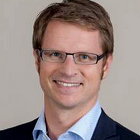 Respect the listener’s trust
Respect the listener’s trust
Radio researcher Jörg Sunnus clears up that people’s demand for ‘believable’ personalities means that they want someone to be honest and trustworthy as a presenter. “In local markets, there are things that can be critically examined. When the host of a local station shows during a telephone conversation with a listener in a clumsy way that he’s not really a citizen and not familiar with the area, then that’s bad for his credibility.”
Combine facts and feelings
Alexander Zeitelhack’s conclusion is that refined audience research, showcasing specific listener typologies, offers “new perspectives” for the radio industry. “Many other sectors have this segmentation, but in radio it’s not common yet. Our focus has been on music research and things like that.” The session host summarizes that human emotions – combined with common sense – are just as relevant for radio as research. In closing, he honors communication philosopher Marshall McLuhan, who called for critical thinking instead of believing anything, with the quotation: “I don’t necessarily agree with everything I say.”
Read also:
- Radio Listener Needs During Prime Time Hours
- Programming (related articles)
Stay tuned, follow us @RadioILOVEIT and click below to share this post:





Add Your Comment